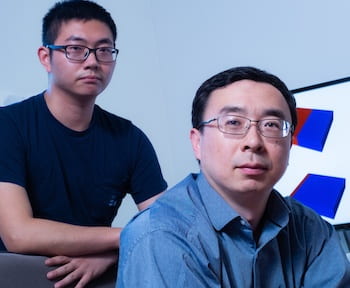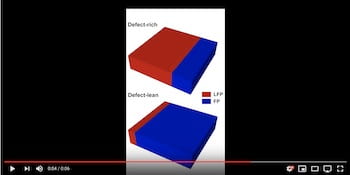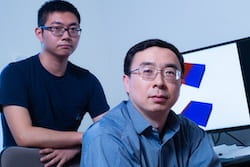NEWS RELEASE
Jeff Falk
713-348-6775
jfalk@rice.edu
Mike Williams
713-348-6728
mikewilliams@rice.edu
Detours may make batteries better
Rice University scientists show point defects in cathode crystals may speed lithium absorption
HOUSTON – (Dec. 9, 2019) – Here’s a case where detours speed up traffic. The result may be better batteries for transportation, electronics and solar energy storage.
Scientists at Rice University’s Brown School of Engineering have discovered that placing specific defects in the crystalline lattice of lithium iron phosphate-based cathodes broadens the avenues through which lithium ions travel. Their theoretical calculations could improve performance up to two orders of magnitude and point the way to similar improvements in other types of batteries.
A cathode undergoes phase transition from iron phosphate (FP) to lithium iron phosphate (LFP) when charged. Rice scientists showed that adding defects to their crystal lattices could help batteries charge faster, as the top animation shows. Animation by Kaiqi Yang
These defects, known as antisites, are formed when atoms are placed at the wrong positions on the lattice — that is, when iron atoms sit on the sites that should be occupied by lithium. Antisite defects impede lithium movement inside the crystal lattice and are usually considered detrimental to battery performance.
In the case of lithium iron phosphate, however, the Rice researchers discovered they create many detours within the cathode and enable lithium ions to reach the reaction front over a wider surface, which helps improve the charge or discharge rate of the batteries.
The research appears in the Nature journal Computational Materials.
Lithium iron phosphate is a widely used cathode material for lithium-ion batteries and also serves as a good model system for studying the physics underlying the battery cycling process, said Rice materials scientist Ming Tang, who carried out the research with alumnus Liang Hong, now a researcher at MathWorks, and graduate student Kaiqi Yang.

An illustration shows a battery’s cathode undergoing phase transition from iron phosphate (FP) to lithium iron phosphate (LFP) during charging. Simulations by Rice University scientists showed that adding defects — distortions in their crystal lattices — could help batteries charge faster. Illustration by Kaiqi Yang
Upon lithium insertion, the cathode changes from a lithium-poor phase to a lithium-rich one, said Tang, an assistant professor of materials science and nanoengineering. When the surface reaction kinetics are sluggish, lithium can only be inserted into lithium iron phosphate within a narrow surface region around the phase boundary — the “road” — a phenomenon that limits the speed at which the battery can recharge.
“If there are no defects, lithium can only enter this small region right around the phase boundary,” he said. “However, antisite defects can make lithium insertion take place more uniformly across the surface, and so the boundary would move faster and the battery would charge faster.

Rice graduate student Kaiqi Yang, left, and materials scientist Ming Tang modeled how engineering defects in the atomic lattice of an iron phosphate cathode can improve the performance of lithium ion batteries. Photo by Jeff Fitlow
“If you force the defect-free cathode to be charged fast by applying a large voltage, there will be a very high local lithium flux at the surface and this can cause damage to the cathode,” he said. “This problem can be solved by using defects to spread the flux over the entire cathode surface.”
Annealing the material — heating without burning it — could be used to control the concentration of defects. Tang said defects would also allow larger cathode particles than nanoscale crystals to be used to help improve energy density and reduce surface degradation.
“An interesting prediction of the model is that this optimal defect configuration depends on the shape of the particles,” he said, “We saw that facets of a certain orientation could make the detours more effective in transporting lithium ions. Therefore, you will want to have more of these facets exposed on the cathode surface.”
Tang said the model could be applied as a general strategy to improve phase-changing battery compounds.
“For structural materials like steel and ceramics, people play with defects all the time to make materials stronger,” he said. “But we haven’t talked much about using defects to make better battery materials. Usually, people see defects as annoyances to be eliminated.
“But we think we can turn defects into friends, not enemies, for better energy storage.”
The U.S. Department of Energy supported the research.
-30-
Read the open-access paper at https://www.nature.com/articles/s41524-019-0255-3.
Follow Rice News and Media Relations via Twitter @RiceUNews.
Related materials:
Mesoscale Materials Science Group: http://tanggroup.rice.edu/research/
Department of Materials Science and NanoEngineering: https://msne.rice.edu
George R. Brown School of Engineering: https://engineering.rice.edu
Video:
A battery’s cathode undergoes phase transition from iron phosphate (FP) to lithium iron phosphate (LFP) during charging. Simulations by Rice University scientists showed that adding defects — distortions in their crystal lattices — could help batteries charge faster, as the top animation shows. (Credit: Animation by Kaiqi Yang/Rice University)
Images for download:
https://news2.rice.edu/files/2019/12/1209_BATTERY-1-WEB.jpg
An illustration shows a battery’s cathode undergoing phase transition from iron phosphate (FP) to lithium iron phosphate (LFP) during charging. Simulations by Rice University scientists showed that adding defects — distortions in their crystal lattices — could help batteries charge faster. (Credit: Kaiqi Yang/Rice University)
https://news2.rice.edu/files/2019/12/1209_BATTERY-2-WEB.jpg
Rice University graduate student Kaiqi Yang, left, and materials scientist Ming Tang modeled how engineering defects in the atomic lattice of an iron phosphate cathode can improve the performance of lithium ion batteries. (Credit: Jeff Fitlow/Rice University)
Located on a 300-acre forested campus in Houston, Rice University is consistently ranked among the nation’s top 20 universities by U.S. News & World Report. Rice has highly respected schools of Architecture, Business, Continuing Studies, Engineering, Humanities, Music, Natural Sciences and Social Sciences and is home to the Baker Institute for Public Policy. With 3,962 undergraduates and 3,027 graduate students, Rice’s undergraduate student-to-faculty ratio is just under 6-to-1. Its residential college system builds close-knit communities and lifelong friendships, just one reason why Rice is ranked No. 1 for lots of race/class interaction and No. 4 for quality of life by the Princeton Review. Rice is also rated as a best value among private universities by Kiplinger’s Personal Finance.




